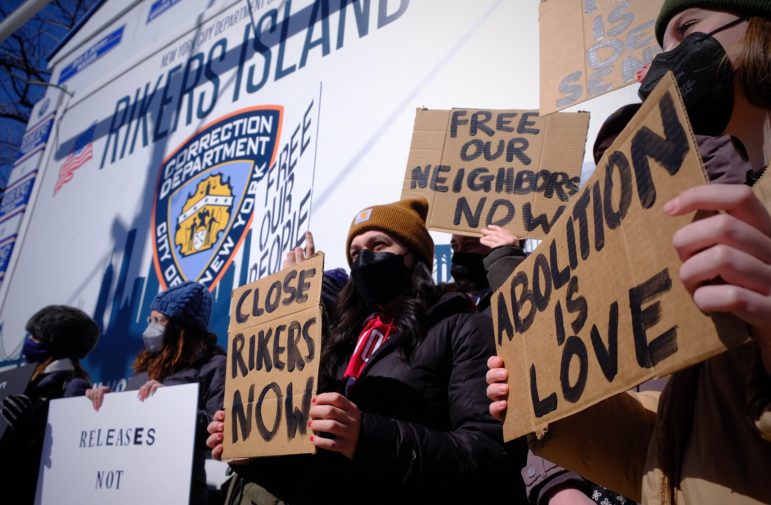The city’s plan to close Rikers by 2027 is “not a perfect plan, but it’s the best plan thus far. And to do the bold and necessary thing—to see this plan through to completion—will take moral courage and political leadership.”

Gerardo Romo/NYC Council
Protestors hold signs calling for the closure of Rikers Island jails at a rally in 2019.Since last year, 29 people have died on Rikers Island and other New York City jails. Late last month, Michael Nieves, 40, was the most recent and fifth person this year to die by suicide. For 10 minutes, two guards and a Captain stood by without assisting Mr. Nieves, who was in a psychiatric intensive supervision area of Rikers when he attempted to take his life. For too many in New York City, a jail sentence has become a death sentence.
The Rikers Island jail complex is due to close by Aug. 31, 2027. Despite the political recriminations, there is not a “Plan A” or “Plan B” for closing Rikers’ Island. There is simply a plan—one that has been thoroughly commissioned, exhaustively researched, debated, voted on, and written about extensively. This plan has survived two administrations, a land-use process, and a pandemic that led to increased unemployment, social isolation, and incidents of crime across the nation. It’s not a perfect plan, but it’s the best plan thus far. And to do the bold and necessary thing—to see this plan through to completion—will take moral courage and political leadership.
READ MORE: Closing Rikers Plan Passes—How We Got Here
Years ago, impacted men and women, religious officials, human rights advocates, lawyers, and community members together laid the groundwork for a broad consensus that Rikers Island should be closed. In 2019, the NYC’s Council of Religious Leaders stated that closing Rikers Island will be “one of the big steps” toward achieving necessary criminal justice reform.
Advocates and jurists alike recognized that rather than addressing or preventing crime, Rikers Island generates more of it. Individuals—more than 50 percent of whom have mental health concerns—are banished to an island and immersed in a violent and chaotic environment, while receiving no substantial treatment for mental health challenges, addictions, or other behavioral health needs.
Michael Nieves, for example, had been diagnosed with multiple serious mental health conditions and had attempted suicide several times before eventually succeeding. Despite being placed in a normally better-functioning mental health unit on the island, he was allowed to bleed to death in full view of two guards and a captain. This environment—survivors, family members, medical experts and others point out—is not a recipe for rehabilitation or transformation. It is a recipe for recidivism, trauma and sometimes death.
In October 2019, the City Council confirmed that Rikers Island was a stain on our city. Councilmembers approved a comprehensive plan to close the jail complex by 2027. This plan included alternatives to incarceration to reduce the jail population, reducing the pipeline that feeds New York’s jails, and replacing the outdated courthouse-adjacent jails in the boroughs to provide improved facilities into which a smaller number of detained people would be transferred when Rikers Island was shuttered.
Less than four months later, COVID-19 struck New York City, infection rates in the jails soared, corrections officers started calling out sick in droves, and the city experienced a rise in crime that continues today. In the midst of this turmoil, a new mayor and City Council took office, and groups who had advocated against the plan to close Rikers lobbied these new electeds to abandon it. To Mayor Eric Adams’s credit and in response to protests about replacing The Tombs, his office spokesperson told The Village Sun, “This administration will always follow the law, and the law says the jails on Rikers Island must close on time.”
It is indeed critical that the Administration follow Local Laws 16, 17, and 18, the Renewable Rikers Act passed in 2021. But when it comes to protecting the basic human dignity of the most despised people in our city and the unpopular corrections officers responsible for them, our elected officials also need to act with moral imagination and long-term vision.
Why imagination? Because despite the talk of building permits, closing Rikers Island is not just a construction job. It is a moral mandate—and as such a difficult mandate. “The life and dignity of the human person must be applied to all,” said Cardinal Dolan on the steps of the New York County Court in 2019.
Imagination in leadership isn’t necessary when everything is going well. When facing competing crises in the areas of homelessness, immigration, gun violence, and healthcare–as the city’s leadership is now—the moral mandates can be perceived as “unrealistic.” Embracing the “Close Rikers” road map and its full vision is more challenging now, when there are more people on Rikers than anticipated. And what if the benefits of sticking to the plan will be fully-realized within another future administration? Supposing audacious moral mandates like these are luxuries for better times?
For all our swagger and tough skin, New Yorkers inhabit a spiritual city–one comprising over 8 million people from every country and religious tradition across the globe. We are a city that for all of our massive diversity is committed to living together in peace and reflecting basic principles of human dignity. Mayor Adams knows the nature of the mandate to close Rikers relates to the spiritual idea that every human being is made in the Divine image. He has accurately referred to Rikers Island as a “national embarrassment” both before and after he was elected mayor.
His administration’s ability to end this embarrassment and contribute to a more humane city will depend on exerting the imaginative leadership and political courage required to close the jail complex before 2027.
Rev. Chloe Breyer is the executive director of the Interfaith Center of New York







